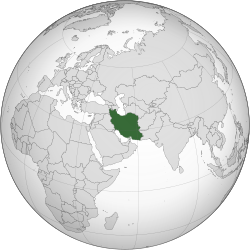รัฐบาลชั่วคราวอิหร่าน
อิหร่าน ایران (เปอร์เซีย) | |||||||||
|---|---|---|---|---|---|---|---|---|---|
| 1979 | |||||||||
 | |||||||||
| เมืองหลวง และเมืองใหญ่สุด | เตหะราน | ||||||||
| ภาษาราชการ | เปอร์เซีย (โดยพฤตินัย) | ||||||||
| ศาสนา | ชีอะฮ์ | ||||||||
| การปกครอง | รัฐบาลเฉพาะกาล | ||||||||
| ผู้นำการปฏิวัติ | |||||||||
• 1979 | รูฮุลลอฮ์ โคมัยนี | ||||||||
| นายกรัฐมนตรี | |||||||||
• 1979 | เมห์ดี บาซาร์กัน | ||||||||
| สภานิติบัญญัติ | สภาการปฏิวัติ | ||||||||
| ประวัติศาสตร์ | |||||||||
| 11 กุมภาพันธ์ 1979 | |||||||||
| 30–31 มีนาคม 1979 | |||||||||
| 4 พฤศจิกายน 1979 | |||||||||
• การสิ้นสุดรัฐบาลชั่วคราว | 6 พฤศจิกายน 1979 | ||||||||
| พื้นที่ | |||||||||
• รวม | 1,648,195 ตารางกิโลเมตร (636,372 ตารางไมล์) | ||||||||
| สกุลเงิน | เรียล | ||||||||
| |||||||||
รัฐบาลชั่วคราวอิหร่าน (เปอร์เซีย: دولت موقت ايران, อักษรโรมัน: Dowlat-e Movaqat-e Irân) เป็นรัฐบาลชุดแรกที่จัดตั้งขึ้นในอิหร่านหลังการปฏิวัติอิหร่าน รัฐบาลนี้นำโดยเมห์ดี บาซาร์แกน หนึ่งในสมาชิกของขบวนการเสรีอิหร่าน,[3] และก่อตั้งตามคำสั่งของอายะตุลลอฮ์ โคมัยนี เมื่อวันที่ 4 กุมภาพันธ์ ค.ศ. 1979 ตั้งแต่วันที่ 4 ถึง 11 กุมภาพันธ์ ชาปูร์ บัคเทียร์ นายกรัฐมนตรีคนสุดท้ายของอิหร่านปาห์ลาวี อ้างตัวว่าเป็นนายกรัฐมนตรีที่ชอบด้วยกฎหมาย โดยบัคเทียร์หนีไปเมื่อวันที่ 11 กุมภาพันธ์[4] เมห์ดี บาซาร์กันเป็นนายกรัฐมนตรีของรัฐบาลชั่วคราวและเสนอคณะรัฐมนตรี 7 คนเมื่อวันที่ 14 กุมภาพันธ์ ค.ศ. 1979 เอบราฮิม ยัซดีได้รับเลือกเป็นรัฐมนตรีต่างประเทศ[5]
รัฐธรรมนูญของสาธารณรัฐอิสลามอิหร่านได้รับการรับรองโดยการลงประชามติเมื่อวันที่ 24 ตุลาคม ค.ศ. 1979 ก่อนที่จะมีผลใช้บังคับในวันที่ 3 ธันวาคม ค.ศ. 1979 รัฐบาลได้สิ้นสุดลงเมื่อวันที่ 6 พฤศจิกายนไม่นานหลังจากการเข้ายึดสถานทูตสหรัฐ[6] จากนั้นสภาปฏิวัติอิสลามก็ขึ้นมาปกครองประเทศ จนกระทั่งมีการจัดตั้งสภาที่ปรึกษาอิสลามชุดแรกเมื่อวันที่ 12 สิงหาคม ค.ศ. 1980 บาซาร์กันได้รับเลือกเข้าสู่สภาที่ปรึกษาอิสลามชุดแรกที่เป็นตัวแทนจากเตหะราน[7]
อ้างอิง
[แก้]- ↑ Sanam Zahir (2008), The Music of the Children of Revolution: The State of Music and Emergence of the Underground Music in the Islamic Republic of Iran with an Analysis of Its Lyrical Content, ISBN 9780549893073,
A contrast to these two anthems is the song that was used during the revolution of 1979 as the de facto national anthem of the transition period. This song, Ey Iran is argued here...
- ↑ The Flag Bulletin, vol. XX, The Flag Research Center, May–June 1981, ISSN 0015-3370,
The development of new symbols in Iran was a slow process. Monuments and other visible expressions of imperial power, especially those associated personally with the deposed shah, were quickly eliminated; the imperial crown immediately disappeared from the war flag and ensign. Nevertheless other flags continued in use – the civil flag and ensign (plain green-white-red stripes) and the state flag and ensign (the same stripes with the lion and sun in the center). The lion and sun also continued as the state arms
- ↑ Reza Safa (2006). The Coming Fall of Islam in Iran: Thousands of Muslims Find Christ in the Midst of Persecution. Charisma Media. p. 78. ISBN 9781591859888.
- ↑ Mir M.Hosseini. "February, 5, 1979 A.D.: Bazargan Becomes Prime Minister". The Iranian history article. คลังข้อมูลเก่าเก็บจากแหล่งเดิมเมื่อ 25 December 2018. สืบค้นเมื่อ 17 July 2016.
- ↑ Samih K. Farsoun, Mehrdad Mashayekhi (22 November 2005). Iran: Political Culture in the Islamic Republic. Routledge. p. 173. ISBN 9781134969470.
- ↑ Nikou, Semira N. "Timeline of Iran's Political Events". United States Institution of Peace. สืบค้นเมื่อ 10 August 2013.
- ↑ Mehdi Noorbaksh. "Mehdi Bazargan's Biography". Cultural Foundation of Mehdi Bazargan. สืบค้นเมื่อ 16 July 2016.


